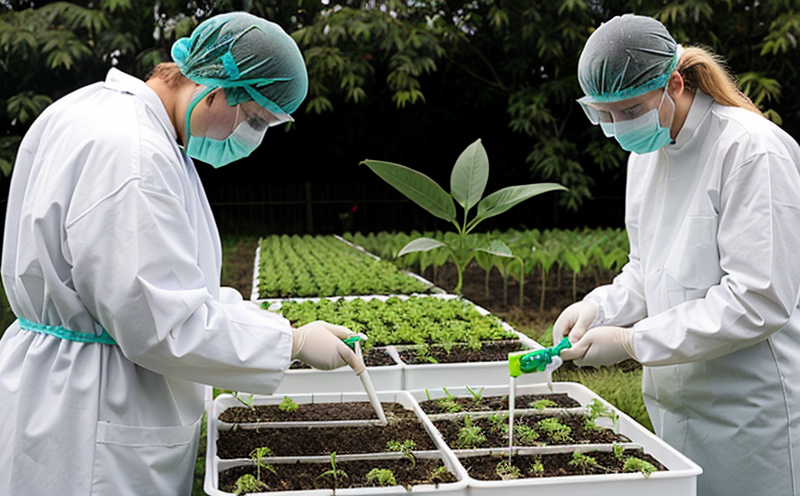Viral RNA Detection Testing in Plants
In the realm of agriculture and forestry, plant health is paramount. Viral infections can significantly impact crop yields and quality, leading to economic losses and reduced food security. Identifying viral pathogens early through accurate and reliable testing is crucial for effective management strategies. This section focuses on Viral RNA Detection Testing in Plants, a critical tool in the arsenal of plant health diagnostics.
The detection of viral RNA using reverse transcription polymerase chain reaction (RT-PCR) techniques is widely recognized as one of the most precise methods available today. RT-PCR allows for the specific amplification and visualization of viral RNA sequences within plant tissues, providing a clear diagnostic tool. This method has replaced less sensitive traditional approaches such as electron microscopy or serological tests.
Accurate detection begins with proper specimen preparation. Plant samples are typically collected from symptomatic areas, ensuring that the chosen tissue contains sufficient viral RNA for analysis. Samples must be kept at optimal temperatures and conditions to prevent degradation of RNA molecules during transport to the laboratory. Once received, these samples undergo homogenization followed by extraction procedures designed to isolate intact viral RNA.
The choice of extraction methods plays a critical role in ensuring successful detection rates. Commonly used kits follow protocols specified in international standards like ISO 17253:2018, which outline best practices for nucleic acid isolation from plant tissues. These protocols emphasize the importance of minimizing mechanical stress during sample processing to preserve RNA integrity.
Following extraction, RT-PCR reactions are set up using primers designed specifically against known viral strains prevalent in agricultural settings. Primers must match target sequences accurately; otherwise, false positives or negatives may occur. Careful optimization ensures that amplification products correspond precisely with expected outcomes based on the chosen primer pair.
After amplification, detection typically involves agarose gel electrophoresis or real-time PCR technologies like TaqMan probes. Agarose gels provide visual confirmation of product sizes indicative of specific viral strains while real-time PCR measures fluorescence intensity as a function of cycle threshold (Ct) values, quantifying the amount of starting RNA.
Interpretation of results involves comparing obtained Ct values against calibrators representing known concentrations. Lower Ct values indicate higher initial RNA levels present in tested samples, suggesting greater viral loads. Interpretations are supported by comparison with accepted reference materials or databases containing sequenced viral genomes.
This comprehensive approach ensures not only accurate identification but also reliable quantification of viral RNA present in plant tissues. Such precision is essential for guiding appropriate interventions aimed at mitigating disease spread and enhancing overall crop resilience.
Why It Matters
Early detection of viruses through Viral RNA Detection Testing in Plants allows growers, researchers, and policy-makers to take proactive measures against potential outbreaks. By identifying infected plants promptly, containment strategies can be implemented before the virus spreads further within fields or nurseries.
The ability to accurately quantify viral loads enables better understanding of pathogen behavior under different environmental conditions. This knowledge informs breeding programs aimed at developing resistant varieties capable of thriving despite challenging circumstances imposed by viral infections.
From an economic standpoint, preventing large-scale crop failures due to disease outbreaks translates into substantial savings for farmers and processors alike. Moreover, maintaining global food security requires robust monitoring systems that can rapidly identify emerging threats before they become widespread issues.
In addition to protecting crops directly, this testing also contributes indirectly by fostering sustainable agricultural practices. By reducing reliance on chemical pesticides where unnecessary, resource use efficiency improves, leading to more environmentally friendly farming operations overall.
Why Choose This Test
The Viral RNA Detection Testing in Plants service offers several advantages over other diagnostic methods currently available. Firstly, its high sensitivity allows for detection even at very low concentrations of viral RNA, making it suitable for identifying asymptomatic carriers or early stages of infection.
Secondly, the specificity of this technique ensures accurate identification of individual viral strains without cross-reactivity concerns present in some serological tests. This capability supports precise epidemiological studies tracking the spread patterns of specific pathogens across regions.
Thirdly, rapid turnaround times are possible thanks to advanced automation equipment employed during specimen handling and processing stages. This speed is particularly beneficial for outbreak situations requiring immediate intervention decisions based on test results.
Last but not least, the availability of detailed quantitative data facilitates better decision-making processes related to treatment protocols or quarantine measures necessary to manage infestations effectively.
International Acceptance and Recognition
The Viral RNA Detection Testing in Plants method has gained widespread acceptance among international regulatory bodies due to its reliability and accuracy. Organizations such as the World Health Organization (WHO), Food and Agriculture Organization of the United Nations (FAO), and International Plant Protection Convention (IPPC) recommend RT-PCR-based approaches for viral detection.
ISO standards like ISO 17253:2018 provide guidance on nucleic acid extraction methods, ensuring consistency across laboratories worldwide. Adoption by these global entities underscores the importance placed upon this technology in maintaining international trade standards and promoting best practices within the agricultural community.
Numerous research institutions have also embraced RT-PCR for its ability to contribute valuable insights into viral biology and ecology. Collaboration between academia and industry partners further enhances the applicability of this testing method across various sectors, including biotechnology and pharmaceuticals.





